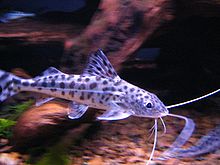Pimelodidae
| Pimelodidae Temporal range:[1]
| |
|---|---|

| |
| Pimelodus pictus | |
| Scientific classification | |
| Domain: | Eukaryota |
| Kingdom: | Animalia |
| Phylum: | Chordata |
| Class: | Actinopterygii |
| Order: | Siluriformes |
| Superfamily: | Pimelodoidea |
| Family: | Pimelodidae Swaison, 1838 |
| Genera | |
|
Aguarunichthys | |
| Synonyms | |
|
Pimelodontidae | |
ThePimelodidae,commonly known as thelong-whiskered catfishes,are afamilyofcatfishes(orderSiluriformes).
Taxonomy
[edit]The family Pimelodidae has undergone much revision. Currently, it contains about 30generaand about 90 recognized and known but unnamed species.[2]Wikipedia lists 109 species in this family. The low-eye catfish (previously family Hypophthalmidae), and thus the genusHypophthalmus,which contains four species, was reclassified with the pimelodids.[3]
This family previously included fish that are now classified underPseudopimelodidae(previously subfamily Pseudopimelodinae) andHeptapteridae(previously subfamily Rhamdiinae).[3]This family also previously includedConorhynchos conirostris,currentlyincertae sedis.[4]However, a molecular analysis has shown unequivocal support formonophylyof the individual families and the genusConorhynchosinto acladecalled Pimelodoidea, including Pimelodidae + Pseudopimelodidae and Heptapteridae +Conorhynchos.[5]
Some genera have relatively recently beensynonymized.MerodontotusandGosliniaare now both included underBrachyplatystoma.[6]Also,Pauliceais now a synonym ofZungaro.[3]
The six main groups within Pimelodidae areSteindachneridion,thePhractocephalus-Leiariusgroup, thePimelodusgroup, theCalophysusgroup,Zungaro,and theSorubimgroup.[6]ThePimelodusgroup includesPimelodus,Exallodontus,Duopalatinus,Cheirocerus,Iheringichthys,Bergiaria,Bagropsis,Parapimelodus,Platysilurus,Platystomatichthys,andPropimelodus.[7]TheCalophysusgroup includes the five generaAguarunichthys,Pimelodina,Calophysus,Luciopimelodus,andPinirampus.[8]
The relationships within each genus are still being studied. Most genera lack a hypothesis formonophyly.[9]
Distribution
[edit]All species of Pimelodidae are found inSouth Americaand the lower Isthmian region.[2]Their range reaches from South America andPanamanorth to southernmostMexico.[3]
Description
[edit]Many long-whiskered catfishes grow to be very large, including thepiraiba,Brachyplatystoma filamentosum,reaching about 3 m (9.8 ft) in length. They have three pairs ofbarbels,with maxillary barbels that may reach the length of the fish's body. Like many other catfishes, their bodies lack scales. The adipose fin is well developed.[3]
Many species of Pimelodidae have juvenile forms that appear differently from their adult forms in color pattern, as well as body shape.[10]Brachyplatystomaspecies have specialized pelagic young with greatly elongated barbels and fin filaments, and strongly ornamented pectoral spines. Other large pimelodids, such asPseudoplatystoma,Sorubim,andSorubimichthys,whose young inhabit vegetated, marginal waters, have distinctive cryptic coloration patterns and much enlarged caudal and pectoral fins.[11]
Ecology
[edit]They are generally bottom-living fish, though some are pelagic and probably filter-feeders.[3]They do not guard their young.[4]
Relationship to humans
[edit]Because of their large size in many species, pimelodids are an important food fish in South America. Many species have beenhybridizedthrough the use ofhormonesin an effort to get even larger fish. This same size factor also makes them very popular forsport fishing.
Pimelodids are a common addition to Amazonian-themed exhibits inzoosandpublic aquaria.
Despite the looming danger of size in many species, pimelodids remain a popular homeaquariumfish. Controversy exists over whether or not many of the larger species should be sold in the hobby because of their adult size. Also, some disagreement occurs over hybrids appearing in the hobby, as well. Many species are hardy and easy to take care of. However, it should be taken into consideration what other fish to house pimelodids with, as they do not hesitate to eat other fish that are small enough.
See also
[edit]References
[edit]- ^Garavello, Julio Cesar (2005)."Revision of genusSteindachneridion(Siluriformes: Pimelodidae) "(PDF).Neotropical Ichthyology.3(4): 607–623.doi:10.1590/S1679-62252005000400018.
- ^abBuitrago-Suárez, Uriel Angel; Burr, Brooks M. (2007)."Taxonomy of the catfish genusPseudoplatystomaBleeker (Siluriformes: Pimelodidae) with recognition of eight species "(PDF).Zootaxa.1512:1–38.Retrieved2009-06-24.
- ^abcdefNelson, Joseph, S. (2006).Fishes of the World.John Wiley & Sons,Inc.ISBN0-471-25031-7.
{{cite book}}:CS1 maint: multiple names: authors list (link) - ^abFroese, Rainer, and Daniel Pauly, eds. (2007)."Pimelodidae"inFishBase.Mar 2007 version.
- ^Sullivan, JP; Lundberg JG; Hardman M (2006). "A phylogenetic analysis of the major groups of catfishes (Teleostei: Siluriformes) using rag1 and rag2 nuclear gene sequences".Mol Phylogenet Evol.41(3): 636–62.doi:10.1016/j.ympev.2006.05.044.PMID16876440.
- ^abLundberg, John G.; Akama, Alberto (2005). Buth, D. (ed.)."Brachyplatystoma capapretum:a New Species of Goliath Catfish from the Amazon Basin, with a Reclassification of Allied Catfishes (Siluriformes: Pimelodidae) "(PDF).Copeia.2005(3): 492–516.doi:10.1643/CI-04-036R1.
- ^Lundberg, John G.; Parisi, Béatrice M. (2002)."Propimelodus,new genus, and redescription ofPimelodus eigenmanniVan der Stigchel 1946, a long-recognized yet poorly-known South American catfish (Pimelodidae: Siluriformes) "(PDF).Proceedings of the Academy of Natural Sciences of Philadelphia.152:75–88.doi:10.1635/0097-3157(2002)152[0075:PNGARO]2.0.CO;2.
- ^Stewart, Donald J. (1986). "Revision ofPimelodinaand Description of a New Genus and Species from the Peruvian Amazon (Pisces: Pimelodidae) ".Copeia.1986(3): 653–672.doi:10.2307/1444947.JSTOR1444947.
- ^Ribeiro, Frank R.V.; Lucena, Carlos A. S.; Lucinda, Paulo H. F. (2008)."Three newPimelodusspecies (Siluriformes: Pimelodidae) from the rio Tocantins drainage, Brazil ".Neotropical Ichthyology.6(3): 455–464.doi:10.1590/S1679-62252008000300019.
- ^Lundberg, John G.; Nass, Pedro; Mago-Leccia, Francisco (1989). "Pteroglanis manniEigenmann and Pearson, a Juvenile ofSorubimichthys planiceps(Agassiz), with a Review of the Nominal Species ofSorubimichthys(Pisces: Pimelodidae) ".Copeia.1989(2): 332–344.doi:10.2307/1445429.JSTOR1445429.
- ^Lundberg, John G.; Berra, Tim M.; Friel, John P. (March 2004)."First description of small juveniles of the primitive catfishDiplomystes(Siluriformes: Diplomystidae) "(PDF).Ichthyol. Explor. Freshwaters.15(1): 71–82. Archived fromthe original(PDF)on 16 July 2014.Retrieved14 July2014.
